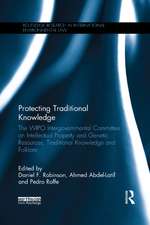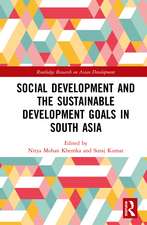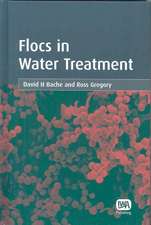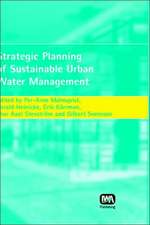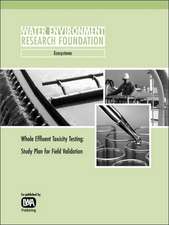Evaluation of Wet Testing as an Indicator of Aquatic Health in Effluent-Dominated Streams: Werf Research Report
Autor Jerry Diamond, James Striblingen Limba Engleză Paperback – 2008
Test acceptance criteria were met for most WET tests, however, this study demonstrated the need to incorporate other MQOs in a full study (such as minimum and maximum percent significant differences and performance on blind samples) to ensure accurate interpretation of effluent toxicity. More false positives, lower test endpoint (i.e., higher toxicity), and more "failed" (non-compliant) tests were observed using No Observed Effect Concentrations (NOEC) as compared to IC25s (concentration causing >= 25% decrease in organism response compared to controls). Algae tests often yielded the most effluent toxicity in this study, however, this test was most susceptible to false positives and high inter-laboratory variability. WET test results exhibited few relationships with bioassessment results, even when incorporating actual effluent dilution. Neither frequency of WET non-compliance nor magnitude of WET were clearly related to differences in biological condition up and downstream of a discharge for the most part. Macroinvertebrate assessments were most able to discriminate small changes downstream of the effluent, followed by periphyton and then fish. The sampling methods used were robust but a full study should collect more field replicates up and downstream of each discharge to increase detection power. Macroinvertebrate and periphyton assessments together appeared to be sufficient to address project objectives. Fish assessments could be useful as well but would entail more effort and cost per site than expended in this project, to be useful.
Din seria Werf Research Report
- 23%
 Preț: 838.44 lei
Preț: 838.44 lei - 23%
 Preț: 787.71 lei
Preț: 787.71 lei - 23%
 Preț: 785.57 lei
Preț: 785.57 lei - 23%
 Preț: 794.56 lei
Preț: 794.56 lei - 23%
 Preț: 794.08 lei
Preț: 794.08 lei - 23%
 Preț: 793.15 lei
Preț: 793.15 lei - 23%
 Preț: 961.97 lei
Preț: 961.97 lei - 23%
 Preț: 794.08 lei
Preț: 794.08 lei - 23%
 Preț: 813.51 lei
Preț: 813.51 lei - 23%
 Preț: 783.70 lei
Preț: 783.70 lei - 23%
 Preț: 812.10 lei
Preț: 812.10 lei - 23%
 Preț: 790.53 lei
Preț: 790.53 lei - 23%
 Preț: 797.16 lei
Preț: 797.16 lei - 23%
 Preț: 805.94 lei
Preț: 805.94 lei - 23%
 Preț: 789.59 lei
Preț: 789.59 lei - 23%
 Preț: 804.06 lei
Preț: 804.06 lei - 23%
 Preț: 799.56 lei
Preț: 799.56 lei - 23%
 Preț: 800.50 lei
Preț: 800.50 lei - 23%
 Preț: 787.24 lei
Preț: 787.24 lei - 23%
 Preț: 798.58 lei
Preț: 798.58 lei - 23%
 Preț: 791.27 lei
Preț: 791.27 lei - 23%
 Preț: 804.53 lei
Preț: 804.53 lei - 23%
 Preț: 790.53 lei
Preț: 790.53 lei - 23%
 Preț: 799.56 lei
Preț: 799.56 lei - 23%
 Preț: 787.71 lei
Preț: 787.71 lei - 23%
 Preț: 850.29 lei
Preț: 850.29 lei - 23%
 Preț: 796.49 lei
Preț: 796.49 lei - 23%
 Preț: 795.29 lei
Preț: 795.29 lei - 23%
 Preț: 965.25 lei
Preț: 965.25 lei - 23%
 Preț: 797.64 lei
Preț: 797.64 lei - 23%
 Preț: 976.65 lei
Preț: 976.65 lei - 23%
 Preț: 785.11 lei
Preț: 785.11 lei - 23%
 Preț: 970.22 lei
Preț: 970.22 lei - 23%
 Preț: 786.51 lei
Preț: 786.51 lei - 23%
 Preț: 795.97 lei
Preț: 795.97 lei - 23%
 Preț: 966.46 lei
Preț: 966.46 lei - 23%
 Preț: 796.49 lei
Preț: 796.49 lei - 23%
 Preț: 794.81 lei
Preț: 794.81 lei - 23%
 Preț: 958.90 lei
Preț: 958.90 lei - 23%
 Preț: 805.94 lei
Preț: 805.94 lei - 23%
 Preț: 806.41 lei
Preț: 806.41 lei - 23%
 Preț: 789.85 lei
Preț: 789.85 lei - 23%
 Preț: 792.20 lei
Preț: 792.20 lei - 23%
 Preț: 957.42 lei
Preț: 957.42 lei - 23%
 Preț: 796.69 lei
Preț: 796.69 lei - 23%
 Preț: 966.93 lei
Preț: 966.93 lei - 23%
 Preț: 964.79 lei
Preț: 964.79 lei - 23%
 Preț: 975.24 lei
Preț: 975.24 lei
Preț: 791.73 lei
Preț vechi: 1028.22 lei
-23% Nou
Puncte Express: 1188
Preț estimativ în valută:
151.50€ • 162.00$ • 126.32£
151.50€ • 162.00$ • 126.32£
Carte tipărită la comandă
Livrare economică 14-19 aprilie
Preluare comenzi: 021 569.72.76
Specificații
ISBN-13: 9781843397687
ISBN-10: 1843397684
Pagini: 130
Dimensiuni: 210 x 279 x 7 mm
Greutate: 0.3 kg
Ediția:New.
Editura: IWA Publishing (Intl Water Assoc)
Seria Werf Research Report
Locul publicării:United Kingdom
ISBN-10: 1843397684
Pagini: 130
Dimensiuni: 210 x 279 x 7 mm
Greutate: 0.3 kg
Ediția:New.
Editura: IWA Publishing (Intl Water Assoc)
Seria Werf Research Report
Locul publicării:United Kingdom



